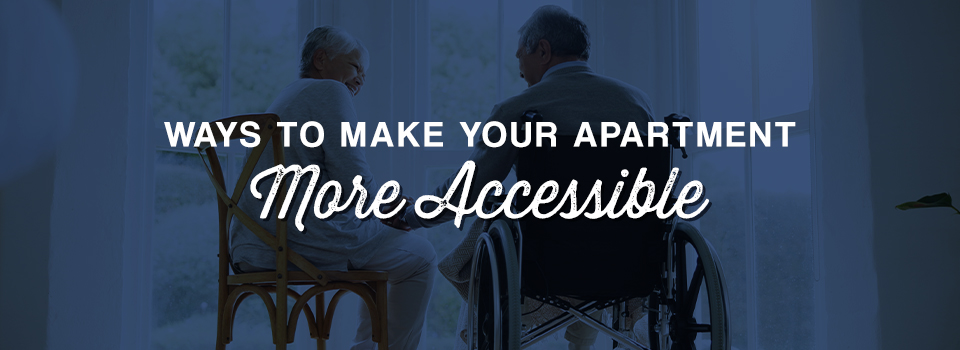

Making your home more accessible is crucial for creating an inclusive living environment and maintaining a comfortable and independent lifestyle. By implementing simple accessibility modifications for apartments, you can ensure your home suits people with mobility needs, visual impairments or other disabilities. Additionally, these modifications can benefit older adults who wish to age in place and maintain their independence.
As a renter, you may wonder how to make your home more accessible, especially if you or a loved one has a physical disability or is older. Let’s explore ways to transform your apartment into an accessible space that promotes safety, mobility and overall well-being.
A point of priority should be ensuring safe and easy navigation throughout the home. As a renter, you may be limited in the permanent modifications you can make, but there are still effective renter-friendly solutions that can help you enhance mobility.
Ideally, your apartment building should have ramps that comply with the Americans with Disabilities Act (ADA) guidelines, which specify the appropriate slope, width and handrails for safe use. If not, ask your landlord to install ramps, or bring up the concern with the Access Board.
You can also install portable options to ensure you or your loved ones can access your home. You can easily place and remove portable ramps, such as threshold ramps or folding ramps, as needed. These ramps are lightweight, durable and can accommodate the height of most doorway thresholds.
You can also install semi-permanent ramps, like modular aluminum ramps, which are easy to assemble and disassemble with minimal tools if you plan to stay at your apartment for a long time. While Medicare may not cover installation expenses, some programs provide funding for assistive technology. You’ll also want to check with your landlord before making these modifications.
As a renter, you can improve the safety and accessibility of your living space with temporary renter-friendly changes without replacing your flooring. For example, you can apply nonslip mats or adhesive strips to slippery surfaces, such as bathroom tiles or hardwood floors, to provide extra traction and ensure an accessible apartment.
Area rugs with nonskid backing can also help prevent slips and falls while adding a decorative touch to your home. If you have concerns about the flooring in your apartment, discuss your options with your landlord or property manager, as they may be willing to make reasonable accommodations to ensure your safety and comfort.
In addition to these solutions, remove tripping hazards, such as electrical cords or clutter, to create clear pathways throughout your apartment for individuals with mobility needs to navigate your home safely.

The bathroom is one of the most critical areas to focus on when creating accessible apartments. Here are some effective renter-friendly modifications to improve bathroom safety:
Remember to discuss any potential modifications with your landlord or property manager. They may be willing to work with you to ensure your bathroom meets your accessibility needs. In some cases, they may even agree to make more permanent changes, such as installing a walk-in shower or a raised toilet, making your home more accessible.
Having an accessible apartment doesn’t require a substantial financial investment. Several simple and cost-effective modifications can improve the accessibility of your home:
Finding a balance between functionality and style is vital when making your apartment more accessible. You can integrate accessibility modifications into your apartment’s existing decor without compromising aesthetics. For example, choosing grab bars that complement your bathroom’s color scheme or selecting stylish motion-activated lamps can enhance both accessibility and visual appeal.
Technology also plays a significant role in creating accessible apartments. Voice-activated smart-home devices, such as smart speakers and lighting systems, can make it easier for people with limited mobility to control their environment. Additionally, consider installing a video intercom system to enable communication with visitors without the need to physically answer the door.
It’s also essential to maintain open communication with your landlord or property manager regarding your accessibility needs. Many landlords are willing to work with tenants to make reasonable accessibility modifications for apartments and ensure a comfortable and accessible living space.
Making your apartment more accessible is crucial to creating a comfortable and inclusive living space for those with physical disabilities or older adults. By implementing renter-friendly modifications, such as portable ramps, temporary flooring solutions, removable grab bars and other budget-friendly changes, you can significantly enhance your home’s safety, mobility and independence. Remember to prioritize open communication with your landlord, as they may be willing to collaborate on making your apartment more accessible.
If you’re looking for accessible apartments in central Pennsylvania, explore Triple Crown Corporation’s rental communities. You’ll find a variety of floor plans and amenities designed to meet your unique needs. Embrace the power of accessible living and enjoy a space that truly feels like home.